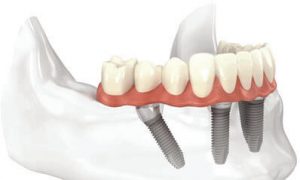
What is Teeth-In-A-Day?
The phrase “teeth-in-a-day” is a marketing tool that was coined, by a very popular dental implant manufacturing company years ago, designed to help sell their implants for a very specific dental implant treatment. The dental implant treatment is the process of a person having their existing unhealthy natural teeth removed, sufficient dental implants inserted into their jawbone, and new teeth permanently attached to the dental implants all in the same day. Thus, providing an amazing alternative to the use of a more traditional and uncomfortable denture. This treatment, when planned and performed correctly, can be the most incredible and life-changing dental solution for a person faced with the difficult decision of losing their natural teeth. When not planned and performed correctly it can be one of the most devastating procedures one can undergo in dentistry.
What is the process to get teeth in a day?
The basic process to successfully complete the teeth-in-a-day treatment involves three basic phases or steps. Phase 1 is diagnosing and planning, Phase 2 is oral surgery and insertion of the healing fixed implant retained teeth, and Phase 3 is the fabrication of the final ceramic fixed implant-retained teeth.
Phase 1 includes a very comprehensive evaluation of one’s oral health and physiology. This is best accomplished by evaluating the health and stability of one’s jaw joints, the esthetics and harmony of one’s teeth with their face, a person’s oral health, including their teeth, their periodontal tissues, and the relationship of their teeth and jaws or occlusion, and most importantly an analysis of one’s jawbone quality and quantity. Some of the records/data that must be recorded would be radiographs (x-rays) both 2D and 3D, photographs of the face and teeth, diagnostic records, or impressions of one’s teeth and how they related or articulate with each other, detailed discussion of the esthetic expectations of the person seeking the treatment. It is so important to carefully gather the most accurate and detailed data. By doing so the proper diagnosis and plan can be developed.
Phase 1 – Data Gathering and Engineering. This phase of treatment includes data gathering from a very detailed examination analyzing all factors related to the proposed treatment and using that data to plan/engineer a successful teeth-in-a-day outcome. The planning should follow a teeth or prosthetic-driven sequence. This means the final tooth position and shape should direct the implant planning process to provide the ultimate success, function, and esthetics. Once the ideal tooth location and position is determined the dental implant position within one’s jawbone can be properly planned and determined. Once the prosthetic teeth are properly designed and the ideal implant locations determined the healing teeth and implant surgical guides are fabricated.
Phase 2 – The actual Teeth-in-a-Day Treatment. During this phase of treatment, the oral surgery required will be completed and the prosthetic healing teeth will be inserted and attached to the new dental implants, all on the same day. The oral surgery will likely include the removal of any natural teeth, insertion of the dental implants into one’s jawbone, and any bone grafting if needed. If the implants inserted into the patient’s jawbone meet a minimal insertion torque value, the healing bridge will be inserted. The surgical and prosthetic procedures should be performed by the most highly skilled, experienced, and trained team of dental specialists, usually, this is a dental surgeon and prosthodontist. The healing teeth make the healing following the oral surgery so much more comfortable and bearable. They also serve as prototype teeth that allow the patient to learn how to chew, speak, and function with a prosthetic tooth. Usually, it will take about 8 to 12 weeks for the bone to heal around the implants. Once the healing is complete one can then move onto phase 3 or fabrication of the definitive fixed implant bridge.
Phase 3 – Final Definitive Teeth Fabrication. Phase 3 of treatment is the process of fabricating the final definitive fixed implant bridge. Usually, this type of prosthesis is made out of Zirconia and porcelain. To properly complete this process a minimum of 4 visits is required. These visits are designed through a series of procedures to replicate the exact position of the dental implants in one’s mouth and use the information gathered from one’s healing prosthetics to design and fabricate a set of final definitive zirconia and porcelain teeth that is esthetically and functionally correct.
It is important to note that the process described above is how the treatment proceeds with the most ideal scenarios. There may be a variety of factors that will change the process. Some of those may include but are not listed to insufficient bone to remove teeth and place implants at the same time, unsuccessful implant surgery, need for sinus augmentation, one quality limitations, and several more. These are very important factors that need to be discussed and evaluated with each patient and how they may directly relate to their treatment prior to proceeding with this amazing and life-changing process.
What is the Success of Teeth-in-a-day?
It’s important to remember that most statistics related to dental implant treatments are established from data developed from the most ideal situations and the most highly trained dental professionals performing the studies and procedures. This type of data and research is most prevalent in the dental science literature or scientific journals. Dental science tells us that dental implant surgeries usually result in a 93 to 97% success rate. The dental literature also suggests that with the teeth-in-a-day treatment, one would expect to see a similar success rate.
What factors might affect implant success with Teeth-in-a-day?
Many factors can influence the overall success of the teeth-in-a-day treatment. The two most important categories that will affect the success of this procedure are:
1) the patient’s ability to heal and their bone anatomy and physiology
2) the skill and expertise of the dental professionals performing the treatment. There are very few conditions that will impede a person from successfully going through dental implant surgery.
Some of the things that might lead to failure a the time of the implant surgery might be autoimmune diseases that impede one’s ability to heal, history of head and neck radiation as part of cancer therapy, history of IV bisphosphonate medication to use to help treat severe cases of osteoporosis and/or cancer, and also the quality and quantity of jaw bone present in one’s mouth. The second category affecting the success of teeth-in-a-day is the skill and training of the professionals performing the procedure. If the proper people are performing the procedures the risks are minimal. If the proper team is not performing the procedure the risks of failure and complications are significantly higher. There are more failures in the real world related to improper diagnosis, planning, and performance than any other reason.
The truth about Teeth-in-a-Day with today’s Market?
Currently, this procedure, teeth-in-a-day, is one of the highly marketed procedures in dentistry. This happens because it is one of the best treatments dentistry has to replace missing teeth and it can be very profitable for those performing the professionals involved in the process. The entities that are involved not the dental side of the equation are the implant manufacturing companies, the dental prosthetic fabrication laboratories, and the dental health care professionals. As a result, the dental implant manufacture companies are trying to sell as many of their implants as they possibly can, and in doing so they are pushing heavily for every dentist (general and specialist) to provide this procedure for their patients. Some of their tactics are more aggressive than others. Ultimately, they strive to sell as many implants as possible. Dental prosthetic fabrication laboratories also see an opportunity to provide their services to more dentists. They too seem to be very aggressive in their approach to encourage dentists (both general and specialists) to provide this procedure to their patients. They have even gone to the extent of devising step-by-step systems and developing situations that convince and persuade the dentists performing the procedure that they will walk them through the “simple” steps of planning and performance to help them successfully complete this procedure. They tell them that “the process is not complicated” and “with their guidance, it will turn out just fine”. Some will even convince the dentist to allow them to complete all the implant planning and prosthetic steps to make their lives easier, so they don’t have to be involved as much. Several implant companies have teamed up with local dental prosthetic fabrication laboratory technicians and local oral surgeons to provide a “quick and easy” solution for the dentist. Their model states that the oral surgeon will find the patients and help provide some minimal records and data to the laboratory technician so that the technician can plan and develop the treatment. Once the technician has completed the treatment development the surgeon will approve it and the surgery will then happen. The oral surgeon will perform the surgery and the technician will perform the teeth in a day part. The technician will then provide a final prosthetic try-in of teeth to the general dentist when the healing is complete. The restorative dentist or general dentist will then try the final set of teeth at a future date and ultimately insert the final teeth. There are so many things wrong with this treatment model both legally, ethically, and somewhat wreck-less in this treatment model. The model is centered around providing a potentially amazing treatment to more people solely with the intent to make more money. It has a very high potential to place the patients’ best interests aside. Some of the legal concerns with this scenario might be an oral surgeon providing prosthetic dental care to a patient, an unlicensed dental technician providing dental care to a patient, an unlicensed dental technician diagnosing and treatment planning oral care for a patient, what part of the treatment team will be responsible for the complications that can and will arise from the treatment. This model is an example of bypassing the most critical and important part of this amazing treatment, the diagnosing, treatment planning, and execution of the treatment by a highly trained dental professional. Most general dentists are not trained adequately on the technique, so the manufacturers are trying to find a way to bypass the dentist’s limitations. These types of scenarios result in a very high probability of complication and failure. Unfortunately, we have started to see more and more of these very devastating outcomes referred to our office when more people are buying into the model.
What can one do to ensure their best outcome with the Teeth-in-a-Day treatment?
Do your research! Find out all the details of how the process will be performed by the person or people involved. This is one of the times that more often than not you’re going to get what you pay for. Some of the questions one may want to ask some are:
· How much experience do you have with diagnosing, planning, and performing the technique?
· Where did you receive the training?
· What kind of training was it?
· Who did they receive the training from?
· How many hours of training did they receive?
· What role is the surgeon going to play?
· If they are going to perform the surgery, what kind of surgical training did they receive? How are they prepared to deal with the possible complications of the surgery?
· What role is the dental prosthetic fabrication laboratory going to play in the treatment?
· What role is the dental implant manufacturing company going to play in the treatment?
· How many of these types of treatments have they performed?
· What are the complications one might expect to see? How do they handle them when they occur?
Contact our office to get more information or to set up a consultation to see if you are a candidate for this proccedure.
